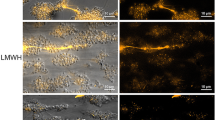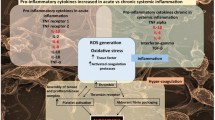Abstract
Sipunculans, a small phylum of coelomated marine worms closely related to polychaete annelids, lack a true circulatory system. We have previously shown that the sipunculan Themiste petricola can form a cellular clot, without congealing, of cell-free coelomic fluid. The clot is formed by the aggregation of large granular leukocytes (LGLs) and may serve not only haemostatic but immune functions, since dissimilar particles may become entrapped within it. We have now evaluated the capacity of a massive clot, induced in vitro by sea water contact, to stop coelomic fluid flow. We have further studied smaller clots induced on glass-slides either with or without the presence of bacteria placed for entrapment within the clot. The fate of clotting LGLs is cell death while forming a cohesive mass, although cytoplasmic and nuclear remnants are shed from the clot. These remnants and any bacteria that avoid clot entrapment or are detached from the clot are engulfed by non-clotting cells that include small granular leukocytes (SGLs) and large hyaline amebocytes (LHAs). Both cell types can be found other than in the clot but SGLs also occur around the clot edges heavily loaded with engulfed material. The cytoskeletal arrangement of SGLs evaluated with phalloidin-rhodamine correspond to motile cells and contrast with that of clotting LGLs that form a massive network of F-actin. Thus, the complementary roles between clotting LGLs and non-clotting SGLs and LHAs act a central immune strategy of Themiste petricola to deal with body wall injury and pathogen intrusion into the coelomic cavity.








Similar content being viewed by others
References
Altincicek B, Stotzel S, Wygrecka M, Preissner KT, Vilcinskas A (2008) Host-derived extracellular nucleic acids enhance innate immune responses, induce coagulation, and prolong survival upon infection in insects. J Immunol 181:2705–2712
Bidla G, Lindgren M, Theopold U, Dushay MS (2005) Hemolymph coagulation and phenoloxidase in Drosophila larvae. Dev Comp Immunol 29:669–679
Blanco GA (2007) Involvement of apoptosis-like cell death in coelomocytes of Themiste petricola (Sipuncula) in the formation of a cellular clot with haemostatic and immune functions. In: Valentino RG (ed) New cell apoptosis research. Nova Biomedical Books, New York, pp 121–160
Blanco GA, Alvarez E, Amor A, Hajos S (1995) Phagocytosis of yeast by coelomocytes of the sipunculan worm Themiste petricola: opsonization by plasma components. J Invertebr Pathol 66:39–45
Blanco GA, Bustamante J, Garcia M, Hajos SE (2005) Hydrogen peroxide induces apoptotic-like cell death in coelomocytes of Themiste petricola (Sipuncula). Biol Bull 209:168–183
Blanco GA, Malchiodi EL, De Marzi MC (2008) Cellular clot formation in a worm: entrapment of foreign particles, cell death and identification of a PGRP-related protein. J Invertebr Pathol 99:156–165
Bohn H (1986) Hemolymph clotting in insects. In: Brehelin M (ed) Cells, molecules, and defense reactions. Springer, Berlin, pp 188–207
Cushing JE, Boraker DK (1975) Some specific aspects of cell-surface recognition by sipunculid coelomocytes. Adv Exp Med Biol 64:35–44
Doyle D (2006) William Hewson (1739-74): the father of haematology. Br J Haematol 133:375–381
Dunn CW, Hejnol A, Matus DQ, Pang K, Browne WE, Smith SA, Seaver E, Rouse GW, Obst M, Edgecombe GD, Sorensen MV, Haddock SH, Schmidt-Rhaesa A, Okusu A, Kristensen RM, Wheeler WC, Martindale MQ, Giribet G (2008) Broad phylogenomic sampling improves resolution of the animal tree of life. Nature 452:745–749
Dybas L (1976) A light and electron microscopic study of the ciliated urn of Phasolosoma agassizii (Sipunculida). Cell Tissue Res 169:67–75
Gandhe AS, John SH, Nagaraju J (2007) Noduler, a novel immune up-regulated protein mediates nodulation response in insects. J Immunol 179:6943–6951
Gregoire C (1951) Blood coagulation in arthropods. II. Phase contrast microscopic observations on hemolymph coagulation in sixty-one species of insects. Blood 6:1173–1198
Gregoire CH, Goffinet G (1979) Controversies about the coagulocyte. In: Gupta AP (ed) Insect hemocytes. Cambridge University Press, Cambridge, pp 189–229
Haine ER, Rolff J, Siva-Jothy MT (2007) Functional consequences of blood clotting in insects. Dev Comp Immunol 31:456–464
Hyman LH (1959) Phylum sipunculida. In: Hyman LH (ed) The invertebrates, vol 5. McGraw-Hill, New York, pp 610–696
Jiravanichpaisal P, Lee BL, Soderhall K (2006) Cell-mediated immunity in arthropods: hematopoiesis, coagulation, melanization and opsonization. Immunobiology 211:213–236
Kristof A, Wollesen T, Wanninger A (2008) Segmental mode of neural patterning in sipuncula. Curr Biol 18:1129–1132
Kroemer G, Galluzzi L, Vandenabeele P, Abrams J, Alnemri ES, Baehrecke EH, Blagosklonny MV, El-Deiry WS, Golstein P, Green DR, Hengartner M, Knight RA, Kumar S, Lipton SA, Malorni W, Nunez G, Peter ME, Tschopp J, Yuan J, Piacentini M, Zhivotovsky B, Melino G (2009) Classification of cell death: recommendations of the Nomenclature Committee on Cell Death 2009. Cell Death Differ 16:3–11
Lavine MD, Strand MR (2002) Insect hemocytes and their role in immunity. Insect Biochem Mol Biol 32:1295–1309
McMahon BR, Smith PJS, Wilkens JL (1997) Invertebrate circulatory systems. In: Danzler WH (ed) Handbook of physiology, vol II. American Physiological Society, New York, pp 931–1008
Mitchison TJ, Cramer LP (1996) Actin-based cell motility and cell locomotion. Cell 84:371–379
Munafo DB, Colombo MI (2001) A novel assay to study autophagy: regulation of autophagosome vacuole size by amino acid deprivation. J Cell Sci 114:3619–3629
Osaki T, Kawabata S (2004) Structure and function of coagulogen, a clottable protein in horseshoe crabs. Cell Mol Life Sci 61:1257–1265
Pincus JH, Chung SI, Chace NM, Gross M (1975) Dansyl cadaverine: a fluorescent probe and marker in cell membrane studies. Arch Biochem Biophys 169:724–730
Ratcliffe NA, Gagen SJ (1977) Studies on the in vivo cellular reactions of insects: an ultrastructural analysis of nodule formation in Galleria mellonella. Tissue Cell 9:73–85
Rice M (1993) Sipuncula. In: Harrison FW, Rice ME (eds) Microscopic anatomy of invertebrates, vol 12: onychophora, chilopoda, and lesser protostomata. Wiley-Liss, New York, pp 237–325
Rowley AF, Ratcliffe NA (1976) The granular cells of Galleria mellonella during clotting and phagocytic reactions in vitro. Tissue Cell 8:437–446
Scherfer C, Karlsson C, Loseva O, Bidla G, Goto A, Havemann J, Dushay MS, Theopold U (2004) Isolation and characterization of hemolymph clotting factors in Drosophila melanogaster by a pullout method. Curr Biol 14:625–629
Schmidt O, Theopold U (1997) Helix pomatia lectin and annexin V, two molecular probes for insect microparticles: possible involvement in hemolymph coagulation. J Insect Physiol 43:667–674
Schulze A, Cutler EB, Giribet G (2007) Phylogeny of sipunculan worms: a combined analysis of four gene regions and morphology. Mol Phylogenet Evol 42:171–192
Shapiro HM (2003) Practical flow cytometry. Wiley-Liss, Hoboken, NJ
Shattil SJ, Cunningham M, Wiedmer T, Zhao J, Sims PJ, Brass LF (1992) Regulation of glycoprotein IIb-IIIa receptor function studied with platelets permeabilized by the pore-forming complement proteins C5b-9. J Biol Chem 267:18424–18431
Solum NO, Murer E (2007) Early studies on the coagulogen (clottable protein) of Limulus polyphemus (horseshoe crab). Thromb Haemost 98:129–130
Stossel TP (1993) On the crawling of animal cells. Science 260:1086–1094
Struck TH, Schult N, Kusen T, Hickman E, Bleidorn C, McHugh D, Halanych KM (2007) Annelid phylogeny and the status of sipuncula and echiura. BMC Evol Biol 7:57
Theopold U, Li D, Fabbri M, Scherfer C, Schmidt O (2002) The coagulation of insect hemolymph. Cell Mol Life Sci 59:363–372
Theopold U, Schmidt O, Soderhall K, Dushay MS (2004) Coagulation in arthropods: defence, wound closure and healing. Trends Immunol 25:289–294
Towle A (1975) Cell types in the coelomic fluid of Phascolosoma agassizii. In: Rice ME, Todorovic M (eds) Proceedings of the International Symposium on the Biology of Sipuncula and Echiura. Naunco Delo, Belgrade, pp 211-218
Triplett EL, Cushing JE, Durall GL (1958) Observations on some immune reactions of the sipunculid worm Dendrostomum zosterticolum. Am Nat 92:287–293
Vida TA, Emr SD (1995) A new vital stain for visualizing vacuolar membrane dynamics and endocytosis in yeast. J Cell Biol 128:779–792
Author information
Authors and Affiliations
Corresponding author
Additional information
This work was supported by CONICET Grant PEI 6377 (to G.B.).
Rights and permissions
About this article
Cite this article
Cavaliere, V., Papademetrio, D.L., Alvarez, E.M.C. et al. Haemostatic and immune role of cellular clotting in the sipunculan Themiste petricola . Cell Tissue Res 339, 597–611 (2010). https://doi.org/10.1007/s00441-009-0912-9
Received:
Accepted:
Published:
Issue Date:
DOI: https://doi.org/10.1007/s00441-009-0912-9




